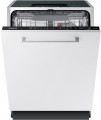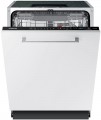Number of programmes
The number of washing programs (modes) provided in the dishwasher. These programs may differ in duration, exposure intensity, water temperature, dish material (for example for delicate dishes), etc. For more information on the different options, see "Washing programs". And the more modes — the more advanced the device is, the more options it provides to choose from. But note that with the same number of programs, their specific set in different models may be different; these details should be clarified separately.
Washing modes
—
Own programme. Possibility to create and save a custom programme by setting the parameters to your liking. This function is convenient because instead of setting the washing settings manually each time, it is enough to save them once in the device’s memory and then simply select a user programme from the list.
—
Half load. A special programme for cases when the dishwasher is loaded with only half of its regular capacity. Running a full-fledged wash in such cases would be too wasteful; so in the half load mode, the dishwasher reduces the consumption of water, detergents and electricity, focus on a reduced amount of dishes. Such a programme is relevant mainly for roomy models (from 8 sets).
—
Pre-rinsing. The "soaking" mode is a program that rinses dishes with cold water and keeps them from drying for a long time, preventing food residues from sticking to the plates. It's useful for storing unwashed dishes for a long time, and for washing heavily soiled dishes without using intensive washing programs.
—
Quick wash. A quick wash programme that saves time. Designed mainly for lightly soiled dishes that do not require particularly intensive exposure; for cope with serious pollution is not suitable.
—
Automatic. This program allows the dishwasher to monitor the washing proc
...ess using sensors that evaluate the water composition during rinsing. The washing process ends when the water is free of impurities, ensuring optimal resource consumption. The washing mode varies by model, with some offering only standard automatic programs and others allowing users to choose the water temperature.
— Economical. A programme that reduces the consumption of water, detergents and electricity compared to a normal washing cycle. Usually, it is intended for dishes without heavy soiling and dried food residues, although individual models may have their own features of the economy mode.
— Delicate (for glass). Special programme for washing delicate dishes, especially that are made of thin glass (goblets, wine glasses, etc.). Washing is carried out at low temperatures (to avoid drops) and with minimal mechanical actions, which allows you to keep delicate dishes intact.
— Hygienic. This program is designed to destroy pathogenic bacteria and viruses effectively. It uses elevated water temperatures (around 68...70°C) that can provide a bactericidal effect without special detergents. This mode is useful for washing children's dishes and can be helpful when someone in the family is sick.
— Intensive. Special programme for washing heavily soiled dishes, such as pans with dried-on food residues. Usually, it provides increased pressure and elevated water temperature.
— Night(quiet). This program is designed for use at night or in situations where excessive noise is undesirable. It reduces the noise produced by the dishwasher by decreasing water temperature, pressure, and using other techniques depending on the model. The necessary washing efficiency is maintained by increasing the operating time, making it suitable for use at night.
— Steam treatment. Hot steam treatment can be used to soften dried food residues and sterilize jars and utensils for home canning. The process consumes a lot of energy.
In addition to the above, other types of programs may be indicated in the specs of dishwashers, in particular:
— Normal. Standard programme for washing lightly soiled dishes with a full load at temperatures around 65 °C. Available in almost all modern dishwashers, but sometimes manufacturers specify its availability separately.
— Plastic utensils. The programme is designed for washing reusable plastic dishes at lower temperatures and intensity than the standard programme to avoid scratches and damage caused by high heat. Not all plastic dishes are compatible with dishwashers, so compatibility should be checked separately. Washing disposable dishes is not recommended.
— Mixed. This category includes all programs that combine several washing modes at once — for example, the normal mode in the compartment for cups and glasses, and the intensive one in the lower part, where you can put a pot or frying pan. Options for such combinations may be different, depending on the model.
— Self-cleaning. Special programme to remove deposits and disinfect the dishwasher. Self-cleaning mode heats water with detergents to remove moderate pollution, and can be run multiple times for tough deposits.Chamber lighting
The presence of a
lighting system in the working chamber of the dishwasher.
Modern dishwashers have deep working chambers which can make it difficult to see the contents, even when the machine is installed in a brightly lit place. A proprietary lighting system solves this problem by improving visibility and doesn't depend on external light sources.
Door closer
The presence of an
door closer in the design of the dishwasher.
An auto-closer is a device that helps close or open a door smoothly to the fully closed or open position, preventing the door from remaining in an intermediate position. It has two functions: ensuring the door is fully closed to prevent splashes and damage, and providing soft closing/opening to prevent shock and damage.
Sliding hinge
Sliding fastening involves connecting the decorative facade to the dishwasher door by means of movable guides. During the opening of the door, the facade “slides” along the sliders, rising a little up, and when it is closed — it drops lower and becomes flush with the adjacent cabinet doors of the kitchen set.
A sliding fastening is used to enable the dishwasher to be built into a column and in order not to cut out the plinth to open the facade.
Controls
—
Rotary switch. Rotary switch control. Usually, it is not the only one control: the rotary knob is used to select the operating mode, and the remaining functions of the dishwasher (start-stop programs, timers, etc.) are controlled by buttons. However, panels with rotary switches still have their own specifics, so they are distinguished as a separate type of control. Technically, this option can be used in dishwashers of all price categories, but for a number of reasons, it is found mainly in inexpensive models.
—
Push-buttons. Controlled by classic mechanical buttons. This option allows you to work even with the very advanced and extensive functionality that is typical for premium dishwashers, while the buttons are cheaper than the
touch panels (see below). Therefore, push-button control can be found in all classes of dishwashers, from low-cost to top-end ones. Its main disadvantage is the presence of slots between the buttons and the panel in comparison with the same sensors, where dirt can clog and cleaning out it can be quite difficult.
— Touch. Control systems with sensors. These controls are easier to operate than simple buttons (see above) — instead of pressing, a light touch is enough. All sensors can be made under the same plane, which makes it easier to clean the control panel and reduces the number of places where dirt can clog. Do not forget t
...hat such control gives the dishwasher a modern and advanced look. On the other hand, sensors are more expensive than other types of control, and therefore are used mainly in high-end models.Country of origin
The country in which the model is manufactured. Despite the fact that most of the capacities are concentrated in China, European factories (
Germany,
Italy,
Poland,
Turkey) for the production of household appliances have not gone away. And certain models can be produced on them. In general, such a division into a Chinese or European factory should not particularly affect the quality of products, but still the stereotype of a reliable European assembly is present in us. However, it is possible that the model may have a country of manufacture, for example, Poland, and in the store under the same article you will meet China.

